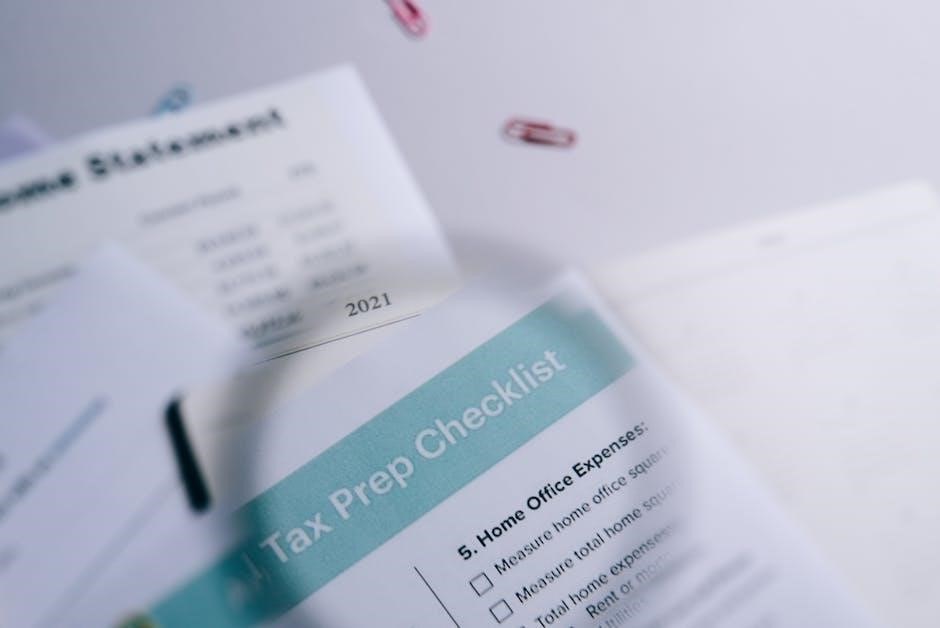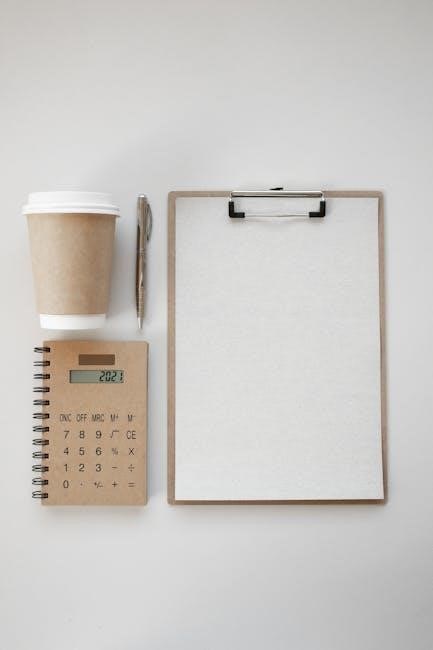AS 3740-2021 outlines criteria for waterproofing domestic wet areas, ensuring durability and compliance. It addresses materials, installation, and maintenance, with updates like mandatory 1800mm waterproofing heights in showers, impacting builders and designers significantly.
1.1 Overview of the Standard
The AS 3740-2021 standard provides comprehensive guidelines for waterproofing domestic wet areas, such as bathrooms, laundries, and balconies. It ensures that these areas are protected against water penetration, which can lead to structural damage and safety hazards. The standard applies primarily to Class 1 buildings (residential dwellings) but also extends to certain commercial applications. It covers materials, installation methods, and maintenance practices to ensure long-term durability and compliance with building regulations. Key updates include enhanced requirements for shower areas, such as mandatory 1800mm waterproofing heights, and stricter compliance measures for builders and designers to adhere to. By following AS 3740-2021, professionals can ensure that waterproofing systems meet current safety and performance standards, preventing costly repairs and maintaining occupant safety.
1.2 Importance of Waterproofing in Residential Buildings
Waterproofing is critical in residential buildings to prevent structural damage, protect against mold growth, and ensure occupant safety. Proper waterproofing prevents water ingress, reducing risks of rot, corrosion, and electrical hazards. It enhances durability, maintains indoor air quality, and protects investments by avoiding costly repairs. Compliance with AS 3740-2021 ensures long-term performance, safeguarding health and property. Effective waterproofing is essential for maintaining the integrity and value of residential structures, addressing both functional and aesthetic needs.
1.3 Historical Context and Evolution of the Standard
AS 3740 originated in 1989, focusing on waterproofing domestic wet areas. The 2012 edition introduced updates on materials and methods, while the 2021 version enhanced shower area requirements and waterproofing heights to 1800mm. These updates reflect industry needs and technological advancements, ensuring safer and more durable constructions. The standard has evolved to address common issues like water ingress and structural damage, making it a cornerstone for Australian building practices.

Scope and Application of AS 3740-2021
AS 3740-2021 applies primarily to Class 1 buildings, detailing waterproofing requirements for domestic wet areas. It also extends to certain commercial applications, ensuring structural integrity and compliance.
2.1 Areas Covered Under the Standard
AS 3740-2021 primarily addresses waterproofing requirements for domestic wet areas, including bathrooms, showers, and laundries. It specifies mandatory heights for waterproofing, such as 1800mm in shower areas, ensuring water resistance. The standard also extends to external areas like balconies and terraces, emphasizing proper membrane installation. While focused on Class 1 buildings, its provisions may apply to certain commercial spaces, ensuring comprehensive protection against water penetration and structural damage. Compliance is essential for maintaining durability and safety in residential and related constructions.
2.2 Applicability to Class 1 Buildings and Beyond
AS 3740-2021 primarily applies to Class 1 buildings, such as single-family homes, but its provisions extend to certain commercial structures. It covers wet areas, including showers, bathrooms, and laundries, ensuring proper waterproofing. The standard also addresses requirements for drainage systems and floor grading, with specific updates like increased waterproofing heights. Compliance is mandatory for builders and designers to prevent structural damage and ensure occupant safety. The standard’s scope ensures comprehensive protection across various building types, emphasizing durability and adherence to modern construction practices.
2.3 Compliance Requirements for Builders and Designers
Builders and designers must adhere to AS 3740-2021 by ensuring all wet areas meet specified waterproofing standards. This includes using approved materials, following installation guidelines, and documenting compliance. Designers must integrate waterproofing into building plans, while builders are responsible for correct implementation. Regular inspections and testing are mandatory to verify adherence. Non-compliance can result in legal consequences and project delays. Proper certification and record-keeping are essential for demonstrating adherence to the standard, ensuring safety and durability in residential constructions.

Key Updates in the 2021 Edition
The 2021 edition introduces significant updates, including increased waterproofing heights to 1800mm in shower areas and enhanced requirements for domestic wet areas, ensuring improved durability and compliance.
3.1 Changes from Previous Editions (e.g., AS 3740-2012)
The 2021 edition introduces significant updates, including a new requirement for waterproofing shower areas to a minimum height of 1800mm above the finished floor. This change aims to reduce water damage risks. Additionally, the standard now includes enhanced detailing for floor waste and drainage integration, addressing common issues from earlier versions. These updates reflect evolving construction practices and stricter compliance expectations, ensuring better durability and safety in residential buildings.
3.2 Enhanced Requirements for Shower Areas
The 2021 update introduces stricter guidelines for shower areas, mandating waterproofing up to 1800mm above the finished floor. This change addresses common water damage issues by ensuring better protection against moisture. The standard now specifies detailed requirements for materials and installation in shower zones, emphasizing seamless integration with drainage systems. Compliance ensures long-term durability and prevents structural damage, aligning with modern building practices and safety standards.
3.3 New Mandates for Waterproofing Heights
The 2021 edition introduces updated requirements for waterproofing heights, particularly in shower areas. The standard now mandates a minimum height of 1800 mm above the finished floor for waterproofing in showers to ensure comprehensive protection against water infiltration. This change addresses previous gaps and aligns with modern building practices. Additionally, the standard specifies that other wet areas, such as bathtubs and spas, must have waterproofing to a minimum height of 150 mm above the floor. These updates aim to enhance durability and prevent water damage in residential buildings, ensuring compliance with current safety and quality standards.

Waterproofing Materials and Methods
Approved materials include waterproof membranes, coatings, and sealants. Correct installation and material compatibility are essential for ensuring durability and compliance with AS 3740-2021 standards.
4.1 Approved Materials for Domestic Wet Areas
AS 3740-2021 specifies approved materials for domestic wet areas, ensuring durability and water resistance. These include polyurethane membranes, acrylic coatings, and PVC-based systems. Materials must adhere to performance criteria, such as flexibility, adhesion, and resistance to moisture and chemicals. The standard emphasizes compatibility with substrates like concrete, plasterboard, and timber. Proper material selection is crucial for compliance, with considerations for substrate type, intended use, and exposure conditions. Always refer to the standard for detailed specifications and compliance requirements.
4.2 Best Practices for Membrane Installation
Proper membrane installation is critical for longevity and leak prevention. Ensure surfaces are clean, dry, and free from contaminants before application. Apply membranes in strict accordance with manufacturer instructions, maintaining continuity across all surfaces. Seal all junctions, corners, and penetrations thoroughly. Conduct regular inspections and tests to verify integrity. Adhere strictly to AS 3740-2021 guidelines for shower areas, requiring membranes to extend to a minimum height of 1800mm; Proper installation ensures compliance and prevents costly future repairs.
4.3 Role of Coatings and Sealants
Coatings and sealants play a critical role in enhancing waterproofing systems by preventing water seepage and ensuring long-term durability. They are applied to surfaces and joints in wet areas, such as bathrooms and laundries, to create impermeable barriers. The standard emphasizes the use of compatible materials that adhere to substrate surfaces effectively. Proper application ensures compliance with AS 3740-2021, safeguarding against leaks and structural damage. Regular inspection of these coatings is essential to maintain their integrity and performance over time.

Design and Installation Guidelines
AS 3740-2021 specifies floor waste and fall requirements, ensuring proper water flow. It mandates waterproofing to a minimum height of 1800mm in shower areas, integrating seamlessly with drainage systems.
5.1 Floor Waste and Fall Requirements
AS 3740-2021 specifies criteria for floor waste and fall requirements in wet areas to ensure proper drainage and prevent water accumulation. It mandates a minimum floor slope of 1:100 to direct water flow towards drainage points. Floor wastes must be installed in shower areas and other wet zones, with drains positioned to avoid water pooling. Regular inspections are required to ensure compliance and maintain functionality over time, safeguarding against structural damage and ensuring a safe, durable environment in residential buildings.
5.2 Minimum Height for Waterproofing in Shower Areas
The 2021 standard mandates waterproofing to a minimum height of 1800 mm above the finished floor in shower areas to prevent water seepage and structural damage. This update ensures comprehensive protection, addressing previous gaps in coverage. Compliance with this requirement is non-negotiable, as it directly impacts the integrity and longevity of residential buildings. Proper installation techniques and materials are essential to meet this height specification, ensuring adherence to the revised AS 3740-2021 guidelines for domestic wet areas.
5.3 Integration with Drainage Systems
AS 3740-2021 emphasizes the critical role of integrating waterproofing with drainage systems to prevent water accumulation and ensure structural integrity. The standard specifies that floor wastes must be correctly graded and connected to drainage systems, ensuring water flows efficiently without compromising waterproofing membranes. Proper integration minimizes the risk of leaks and water damage, aligning with the mandatory waterproofing heights and membrane installation requirements. This approach ensures compliance with safety and durability standards, safeguarding buildings from long-term damage.

Testing and Inspection
AS 3740-2021 requires mandatory tests for waterproofing integrity, including water immersion and pressure tests. Inspection checklists ensure compliance, and detailed documentation is necessary for certification and future reference.
6.1 Mandatory Tests for Waterproofing Integrity
AS 3740-2021 specifies mandatory tests to ensure waterproofing systems’ integrity. These include water penetration and flood testing to verify membrane performance. Compliance requires thorough inspections and documented results. Builders must conduct these tests post-installation to validate system durability and adherence to standards. The tests are critical for preventing leaks and structural damage, ensuring long-term reliability in domestic wet areas. Proper documentation is essential for certification and compliance verification. These tests are non-negotiable for meeting the standard’s requirements.
6.2 Inspection Checklist for Compliance
A thorough inspection checklist ensures adherence to AS 3740-2021 standards. Key items include verifying membrane integrity, checking for damage or gaps, confirming proper material usage, and ensuring drainage integration. Visual assessments of waterproofing heights, particularly in shower areas, are critical. Documentation of findings and any required repairs must be maintained. Compliance also involves validating that all components meet specified criteria, with a focus on preventing water ingress and ensuring long-term durability of the waterproofing system.
6.3 Documentation Requirements
Thorough documentation is essential for compliance with AS 3740-2021. This includes test results, inspection reports, and material certifications. Records of maintenance and repairs must be kept, ensuring traceability and accountability. All documents should be accessible for regulatory inspections, demonstrating adherence to the standard. Proper documentation prevents non-compliance issues and facilitates audits, ensuring the longevity and integrity of waterproofing systems in residential buildings.

Maintenance and Repair
Regular inspections and addressing leaks promptly are crucial. Proper cleaning and resealing of joints ensure longevity, while proactive maintenance prevents water damage and extends system lifespan effectively.
7.1 Regular Maintenance Practices
Regular maintenance is crucial for ensuring the longevity of waterproofing systems. Property owners should conduct routine inspections of wet areas, including showers and bathrooms, to identify potential issues early. Cleaning drain outlets and ensuring proper water flow prevents blockages that could lead to water damage. Checking for cracks in tiles, grout, and membranes is essential, as even minor damage can compromise waterproofing integrity. Additionally, maintaining proper ventilation in wet areas helps reduce moisture buildup, which can degrade waterproofing materials over time. Regular maintenance practices not only prevent costly repairs but also ensure ongoing compliance with AS 3740-2021 standards.
7.2 Identifying and Addressing Leaks
Identifying leaks in waterproofing systems requires regular inspections and monitoring for signs like water stains or mold. Early detection prevents structural damage. The 2021 standard emphasizes detailed documentation of inspections to ensure compliance. When addressing leaks, it is critical to stop water exposure and assess the extent of damage. Repairs often involve cleaning the area, applying sealants, or replacing damaged membranes. Follow-up inspections are essential to confirm the effectiveness of repairs, ensuring long-term integrity and compliance with AS 3740-2021 guidelines.
7.3 Extending the Lifespan of Waterproofing Systems
Regular inspections and maintenance are crucial for extending the lifespan of waterproofing systems. Ensuring that all elements, such as membranes and sealants, remain intact prevents premature degradation. Using high-quality materials compliant with AS 3740-2021 standards further enhances durability. Proper installation techniques, as outlined in the 2021 updates, also play a significant role in minimizing wear and tear over time.
Compliance and Certification
AS 3740-2021 requires certification of waterproofing systems, ensuring adherence to standards. Documentation and inspections by authorities verify compliance, with non-compliance leading to potential legal consequences and fines.
8.1 Certifying Waterproofing Systems
Certification of waterproofing systems under AS 3740-2021 ensures compliance with safety and durability standards. Builders and designers must document materials and installation methods, while third-party inspections validate adherence to criteria. The 2021 update emphasizes mandatory testing for integrity, with specific focus on shower areas and drainage integration. Compliance certification is essential for legal approval, protecting both developers and homeowners from structural risks. Proper documentation and inspection records are required to verify conformity with the standard.
8.2 Role of Authorities and Inspectors
Authorities and inspectors play a crucial role in enforcing AS 3740-2021 compliance. They conduct site inspections to verify adherence to waterproofing standards, review designs, and ensure materials meet specifications. Inspectors validate test results and certifications, ensuring all requirements are fulfilled; Their oversight guarantees that builders and designers comply with the standard, maintaining the integrity and safety of waterproofing systems in residential and commercial buildings. Proper documentation and approval are essential for certification.
8.3 Consequences of Non-Compliance
Non-compliance with AS 3740-2021 can lead to severe legal and financial repercussions. Builders and designers may face penalties for failing to meet mandatory requirements, such as the 1800mm waterproofing height in shower areas. Non-compliant installations can result in water damage, structural issues, and health hazards from mold growth. Homeowners may experience costly repairs and potential legal disputes. Insurance claims could also be denied if non-compliance is proven. These consequences underscore the importance of adhering to the standard to avoid financial and reputational damage.
- Legal penalties for non-compliance.
- Financial losses from repairs and disputes.
- Reputational damage for builders and designers.

Case Studies and Practical Examples
This section explores real-world applications of AS 3740-2021, showcasing successful residential projects, lessons from non-compliant installations, and innovative waterproofing solutions.
9.1 Successful Implementation in Residential Projects
Residential projects complying with AS 3740-2021 demonstrate enhanced durability and reduced maintenance. A notable case involves a multi-story dwelling where 1800mm waterproofing heights in showers prevented leaks, ensuring long-term integrity. Proper membrane installations and drainage integration were key. Such projects highlight the standard’s effectiveness in addressing common issues like water ingress and structural damage, setting benchmarks for future developments. These successes underscore the importance of adhering to updated standards for reliable and sustainable outcomes in residential construction.
9.2 Lessons Learned from Non-Compliant Installations
Non-compliant waterproofing installations often result from inadequate materials or poor workmanship. Common issues include insufficient waterproofing heights, improper membrane detailing, and failure to integrate with drainage systems. These oversights can lead to structural damage, mold growth, and costly repairs. For instance, ignoring the 1800mm waterproofing requirement in showers has caused water ingress and damage. Such cases highlight the importance of adhering to AS 3740-2021 guidelines to avoid premature system failure and legal liabilities. Regular audits and compliance checks are essential to prevent these errors.
9.3 Innovative Solutions in Waterproofing
Innovative waterproofing solutions now incorporate advanced materials like self-healing membranes and eco-friendly coatings. Modular, prefabricated systems streamline installation, reducing labor costs. Smart coatings with hydrophobic properties enhance durability. Nanotechnology-based sealants offer superior water resistance. These cutting-edge approaches align with AS 3740-2021 requirements, ensuring compliance while addressing modern challenges. such innovations not only improve efficiency but also minimize environmental impact, setting new benchmarks in waterproofing technology.

Industry Impact and Adoption
The 2021 AS 3740 update influenced manufacturers to adapt products, sparked training programs for professionals, and saw varied industry responses to compliance challenges and material updates.
10.1 Industry Response to the 2021 Updates
The 2021 updates to AS 3740 received a mixed but largely positive response from the construction industry. Builders and manufacturers adapted to new mandates, such as increased waterproofing heights and enhanced shower area requirements. Training programs emerged to help professionals comply with updated standards. Some manufacturers redesigned products to meet stricter criteria, while others emphasized the importance of adherence to maintain trust and quality in the market. Overall, the industry acknowledged the updates as necessary for improving durability and safety in residential buildings.
10.2 Training Programs for Professionals
Training programs for professionals focus on AS 3740-2021 updates, ensuring compliance with new requirements like 1800mm waterproofing heights in showers. Programs cover installation best practices, materials, and compliance. Offered by industry bodies, manufacturers, and educational institutions, these courses include practical workshops and online modules. They emphasize understanding updated standards, drainage integration, and membrane applications. Assessments and certifications are often included to verify proficiency. Such programs are crucial for builders, architects, and installers to stay updated and deliver compliant, durable waterproofing solutions, aligning with regulatory and safety expectations.
10.3 Manufacturer Adaptations to New Standards
Manufacturers have adapted to AS 3740-2021 by developing products meeting updated requirements. This includes creating materials compliant with new waterproofing heights and enhanced shower area standards. Companies now offer tailored solutions, such as advanced membranes and coatings, to align with the standard’s specifications. Collaboration with industry experts ensures products meet durability and performance expectations, supporting builders and designers in compliance. These adaptations reflect the industry’s commitment to quality and safety, ensuring materials are fit for modern construction demands.

Future Trends in Waterproofing
Future trends include advanced materials, smart technologies, and sustainable practices. AS 3740 may evolve to incorporate eco-friendly solutions and innovative methods, enhancing durability and environmental compliance.
11.1 Emerging Technologies in Waterproofing Materials
Emerging technologies in waterproofing materials include advanced liquid-applied membranes, self-healing coatings, and nanotechnology-based solutions. These innovations enhance durability, flexibility, and environmental sustainability. Liquid-applied membranes offer seamless application and superior adhesion, while self-healing coatings repair minor cracks autonomously. Nanotechnology improves water repellency and strength. Eco-friendly materials like bio-based polymers are gaining traction, aligning with sustainability goals. These advancements not only meet AS 3740-2021 requirements but also pave the way for future updates, ensuring improved performance and compliance in waterproofing systems.
11.2 Sustainability and Environmental Considerations
The AS 3740-2021 standard emphasizes sustainability by promoting eco-friendly materials and practices. It encourages the use of durable, low-maintenance waterproofing systems, reducing long-term environmental impact. Energy-efficient solutions and waste reduction during installation align with green building principles. The standard also supports materials with lower embodied energy, contributing to environmental sustainability. By integrating sustainable practices, AS 3740-2021 helps balance high-performance waterproofing with environmental responsibility, ensuring compliance with modern eco-conscious construction goals.
11.3 Potential Future Updates to the Standard
Future updates to AS 3740-2021 may focus on emerging waterproofing technologies and sustainability. Advances in materials like self-healing membranes or eco-friendly coatings could be incorporated. Additionally, updates might address climate resilience, adapting to extreme weather conditions. Industry feedback and environmental trends will likely influence these changes, ensuring the standard remains relevant and effective in safeguarding buildings against water damage.
AS 3740-2021 ensures durable waterproofing solutions, preventing water damage and enhancing safety in residential buildings through updated requirements and compliance standards.
12.1 Summary of Key Takeaways
The AS 3740-2021 standard provides a comprehensive guide for waterproofing domestic wet areas, emphasizing compliance with updated requirements like 1800mm waterproofing heights in showers. It ensures durability, prevents water damage, and enhances safety in residential buildings. Regular maintenance and adherence to installation guidelines are critical for extending the lifespan of waterproofing systems. Compliance with this standard is essential for avoiding structural issues and legal consequences, ensuring long-term protection and reliability in construction projects.
12.2 Final Thoughts on the Importance of Compliance
Adhering to AS 3740-2021 is crucial for ensuring structural integrity, preventing water damage, and avoiding legal repercussions. Compliance safeguards homeowners from costly repairs and enhances property value. Non-compliance risks safety hazards, financial losses, and potential legal action. By following the standard, professionals uphold industry best practices, protect their reputation, and contribute to reliable, durable constructions. Ultimately, compliance ensures peace of mind for all stakeholders, making it an indispensable aspect of modern building practices.
